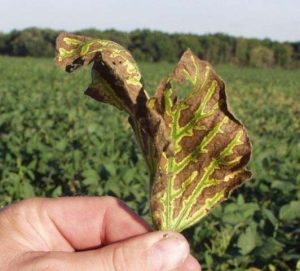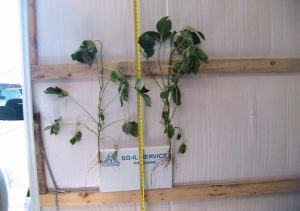 Is this soil-born disease affecting your fields this season? If so, you are not alone. Traveling around both Missouri and Iowa, I have seen it just about everywhere. I hear from my coworkers that it is in Illinois, too. So why has it hit so hard this year?
Is this soil-born disease affecting your fields this season? If so, you are not alone. Traveling around both Missouri and Iowa, I have seen it just about everywhere. I hear from my coworkers that it is in Illinois, too. So why has it hit so hard this year?
- Planting time conditions – early planting dates into cool, wet soils.
- Conditions at blooming stage.
- Cooler, damp conditions throughout reproductive stage of soybean plant.
- Cyst nematodes.
These are the reasons that we all are hearing, and we sure had them in this growing season. What these conditions do is trigger Fusarium in the soil to work much more efficiently to cause SDS and lower yields 20-40%, and in some cases, more.
Here is another theory. For the past ten plus years, we as producers have been using a lot of glyphosate in our bean production to control weeds. And, for the past five or so years, we have been battling resistant weeds with increased rates. According to Dr. Don Huber, Emeritus Professor of Plant Pathology Purdue University, the increased use of glyphosate is causing a buildup of the chemical in our soil. This can trigger numerous diseases in all of our crops. The following is from a presentation given by Dr. Huber. Its focus is just on soybeans:
- Soybeans Root rot, Target spot Corynespora cassicola
- Soybeans White mold Sclerotina sclerotiorium
- Soybeans SDS Fusarium solani f.sp. glycines
Here are some observations which I have made during the growing season:
- Where high rates of glyphosate have been used, SDS is more prevalent.
- Later planting dates (after June 1st), less, if any SDS.
- Fields have received little or no glyphosate, less, if any SDS.
- Liberty Link beans, lower incidents of SDS.
- Conventional beans, lower incidents of SDS.
So what can we do as soybean growers to combat this spike in SDS?
- Rotate crops!
- Rotate modes of action in herbicide programs!
- Adjust planting dates, so the conditions are closer to ideal for planting.
- Choose soybean varieties that have the best tolerance to SDS and cyst nematodes.
- Choose soybean varieties which allow for other herbicide modes of action.
- Help the soil become healthy again!
According to Dr. Huber, we must detoxify the soil, especially in the root zone. SO-IL Cal is our 10% soluble calcium product which can do the following:
- Nitrogen stabilization when applied with or prior to a nitrogen application
- SO-IL Cal can be added at 3 gallon per acre to UAN solutions (28 or 32%)
- Energy to enhance the chemical reactions between cations and the colloids in our soil
- Available calcium – Many times more soluble than gypsum
- Antioxidant capability to aid soil in fighting off damaging soil fungi and diseases
- An organic complexing reagent to release soluble calcium from soil limestone
- Energy and carbohydrates for all beneficial soil microbes
- Pesticide compatibility except any glyphosate formulation
- Compatibility with BioFeed® and BioCarb® but should not be used with any other fertilizer containing phosphate or potash
What we recommend is to start this fall with an application of our Nutrient Recycling Program. This program can help accomplish the following:
- Maximize Crop Residue Breakdown by stimulating Mycorrhizae and aerobic bacteria populations
- Reduce soil compaction
- Provide energy and carbohydrates for crop and soil microbes
- Readily available soluble calcium
- Stabilize Nitrogen – Increase yields with reduced NPK rates
- Antioxidant capability to aid soil in fighting off damaging soil fungi and diseases
Maximizing residue breakdown could be one of the most important management decisions made this year. With projected high corn yields, there will be a lot of nutrients removed from our fields. For example, a 170 bpa corn crop removes 190 lbs. N, 87 lbs. P, 230 lbs. K, 26 lbs. Sulfur, and 24 lbs. of Calcium total in the grain and stover. Let’s focus on the stover, the residue left in the field.
There is about 76 lbs. of N, 27 lbs. P, and 187 lbs. of K in the residue. How much is that worth with today’s dry fertilizer price? $50 to $75 per acre?! And that’s not including the sulfur and calcium.
Compare that to the Nutrient Recycling Program at around $28 per acre. Even if you are adding some 12-0-0-26 in the carrier to get some sulfur and help feed the bacteria that break down the residue, and the cost of the application, the price is still below $45 per acre.
 The photo to the right is from a field that had been treated with the NRP in the fall previous to planting the bean crop. The plant on the right received the program after a corn crop, while the plant on the left was in the check area which did not receive the program. The NRP treated area of the field was healthier, had better root systems, and has the potential to yield more if Mother Nature cooperates. Which do you want in your fields?
The photo to the right is from a field that had been treated with the NRP in the fall previous to planting the bean crop. The plant on the right received the program after a corn crop, while the plant on the left was in the check area which did not receive the program. The NRP treated area of the field was healthier, had better root systems, and has the potential to yield more if Mother Nature cooperates. Which do you want in your fields?
Here is how to contact me to discuss these issues further or get started with the NRP as harvest gets started, in other areas contact your local SO-IL Service representative or call our office, 888-313-2360 or 217-357-2360.
Phone – voice/text – 573/680/6951
Email – jviertel@soilserviceinc.com
Hope you have a safe and trouble free harvest!
